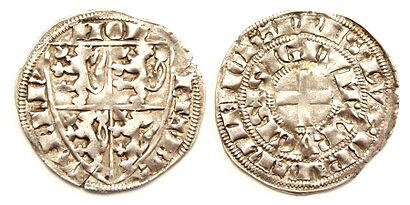John III, Duke of Brabant facts for kids
Quick facts for kids John III |
|
|---|---|
| Duke of Brabant Duke of Lothier Duke of Limburg |
|

John's effigy in a seal
|
|
| Born | 1300 |
| Died | 5 December 1355 Brussels |
| Burial | Villers Abbey |
| Spouse | Marie d'Évreux |
| Issue | Joanna, Duchess of Brabant Margaret of Brabant Marie of Brabant John Henry Godfrey |
| House | House of Reginar |
| Father | John II, Duke of Brabant |
| Mother | Margaret of England |
John III (born 1300, died 5 December 1355) was an important ruler in the Middle Ages. He was the Duke of Brabant, Lothier, and Limburg. These areas are now part of modern-day Belgium and the Netherlands. John III ruled for over 40 years, from 1312 until his death.
Contents
Life as Duke of Brabant
John III was the son of John II, Duke of Brabant, and Margaret of England. He became duke in 1312 after his father passed away. His father had created the Charter of Kortenberg, which gave more power to the towns. To make friends with France, John III married Marie of Evreux.
The Power of Brabant's Towns
The early 1300s were a time of great growth for Brabant. The towns in the duchy became very important. Their main business was making cloth, which needed wool from England.
Because of the Charter of Kortenberg, the towns had a say in how the duchy was run. They could even choose advisors to help rule when John III was young. This meant the towns had a lot of power.
In 1316, the King of France, Louis X, asked John to stop trading with Flanders. The towns said no, because it would hurt their businesses. In return, France stopped all trade with Brabant. This showed how much influence the towns had. Later, in 1356, the towns were so powerful that John's daughter had to agree to a special document called the Joyous Entry. This document gave the towns even more rights.
Alliances with France and England
John III had to deal with powerful neighbors like France and England. These two countries were often at war. John tried to stay neutral at first, but it was hard.
Joining the French Side (1332–1337)
Many rulers near Brabant became John's enemies. This was often because the King of France, Philip VI of France, encouraged them. These enemies included the Count of Flanders and the Prince-Bishop of Liège.
In 1332, John had a problem with the French king. John had given a safe place to Robert, a French count who was on his way to England. King Philip of France was angry. John reminded Philip that he ruled Brabant on his own, not as a servant of France.
After a short fight, John made a deal with Philip. John became a "vassal" of France, which meant he promised loyalty to the French king. He also received money from Philip. John's oldest son was even set to marry Philip's daughter. This alliance made John stronger against the Holy Roman Emperor, who was technically his overlord.
Switching to the English Side (1337–1345)
In 1337, Edward III of England decided to claim the crown of France. This started the Hundred Years' War. John III, who was Edward's cousin, decided to become an ally of England.
Edward wanted Brabant's help because it would hurt Flanders, which was allied with France. If English wool went to Brabant instead of Flanders, Brabant's towns would benefit. Edward promised John a lot of money and protection for Brabant's merchants. John agreed to send 1,200 soldiers to help Edward in France.
The alliance was kept secret at first. It became public when Edward landed his troops in Antwerp in 1338. John received the money he was promised. He also agreed that his second daughter, Margaret, would marry Edward, the Black Prince, who was the heir to the English throne. However, after a few years of fighting, Edward ran out of money and went back to England.
Back with France (1345–1355)
As England's money ran out, John's alliance with England weakened. In 1345, Brabant started talking with France again. By 1347, Brabant was officially allied with France once more.
Margaret, John's daughter, was now set to marry Louis of Male, the Count of Flanders. This was important because Flanders was a rival of Brabant. They also settled a dispute over the Lordship of Mechelen, a key area within Brabant. It was agreed that Mechelen would be fully controlled by Brabant. John remained loyal to France until he died in 1355.
John III's Family
In 1311, John married Marie d'Évreux (1303–1335). They had several children:
- Joanna, Duchess of Brabant (born 1322, died 1406): She married twice.
- Margaret of Brabant (born 1323, died 1368): She married Louis II, Count of Flanders.
- Marie of Brabant (born 1325, died 1399): She married Reginald III of Guelders.
- John of Brabant (born 1327, died 1335/36): He married Marie of France but died young.
- Henri of Brabant (died 1349): He was Duke of Limburg but also died young.
- Godfrey of Brabant (died after 1352): He was Lord of Aarschot and died young.
John also had a son named John I Brant from another relationship.
Sadly, all three of John III's legitimate sons died before him. This meant he had to name his eldest daughter, Joanna, as his heir. This caused some problems after his death because it was unusual for a woman to inherit such a powerful title. John III was buried in the Cistercian Abbey of Villers in Belgium.


